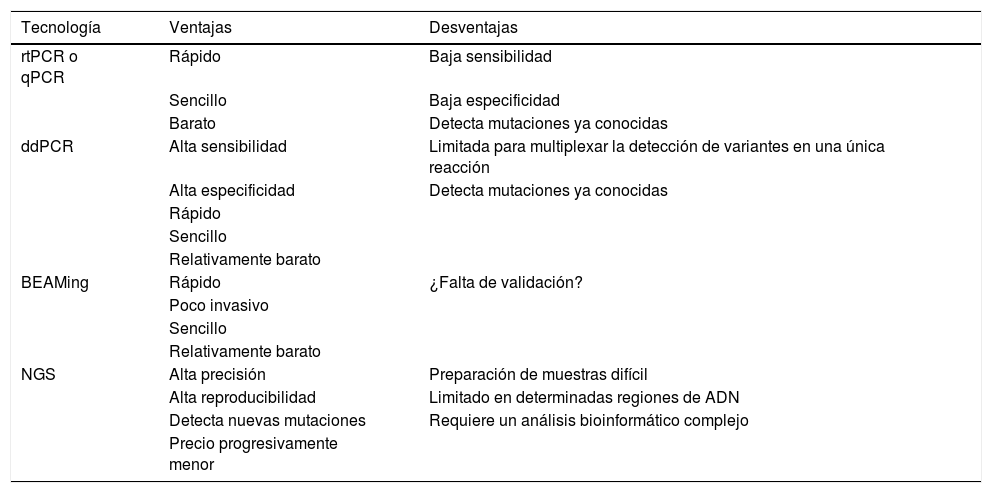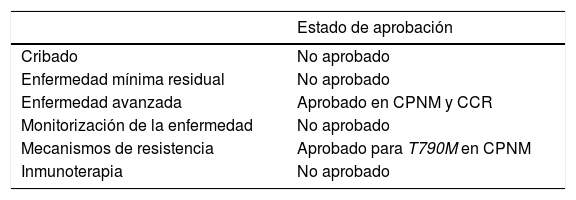Los pacientes con cáncer y alteraciones oncogénicas potencialmente tratables están aumentando de forma considerable. El diagnóstico de estas alteraciones permite frecuentemente realizar un tratamiento personalizado inicial o a la progresión, así como conocer información predictiva sobre la eficacia de la inmunoterapia. Sin embargo, en un 25% de los casos, la biopsia de tejido inicial no es informativa o no es posible realizar el perfil genómico tumoral a la progresión por la dificultad para obtener nuevas biopsias de tejido tumoral. Por ello, son necesarias alternativas diagnósticas eficaces para la estratificación molecular, que permitan una valoración dinámica del perfil genómico tumoral, como la biopsia líquida, reflejando además la heterogeneidad genómica en el seno del mismo paciente. Actualmente, existen distintas técnicas diagnósticas de biopsia líquida, cada una con distintos grados de precisión y rendimiento. El objetivo de este consenso de la Sociedad Española de Anatomía Patológica (SEAP) y la Sociedad Española de Oncología Médica (SEOM) es evaluar la viabilidad y efectividad de las distintas técnicas de biopsia líquida en el paciente con cáncer en la práctica clínica diaria.
Los expertos de este consenso concluyen que la biopsia líquida es una alternativa aceptable a la biopsia de tejido para el estudio de biomarcadores. Sin embargo, es importante estandarizar los procedimientos preanalíticos y analíticos, garantizar su reproducibilidad, así como generar informes clínicos estructurados y comprensibles. La implementación de comités multidisciplinares de evaluación de las alteraciones moleculares es fundamental para mejorar estos procesos y favorecer las decisiones terapéuticas más adecuadas para cada paciente con cáncer en función de perfil genómico.
The proportion of cancer patients with tumours that harbour a potentially targetable genomic alteration is increasing considerably. The diagnosis of these genomic alterations can lead to tailoring of treatment, at the onset of disease or during progression, as well as providing additional, predictive information on the efficacy of immunotherapy. However, in up to 25% of cases, the initial tissue biopsy is inadequate for precision oncology and, in many cases, tumour genomic profiling at progression is not possible due to technical limitations of obtaining new tumour tissue specimens. Efficient diagnostic alternatives are therefore required for molecular stratification, such as liquid biopsy. This technique enables the evaluation of the tumour genomic profile dynamically and as well as capturing intra-patient genomic heterogeneity. To date, there are several diagnostic techniques available for use in liquid biopsy, each with different precision and performance levels. The objective of this consensus statement of the Spanish Society of Pathology (SEAP) and the Spanish Society of Medical Oncology (SEOM) is to evaluate the viability and effectiveness of the different methodological approaches of liquid biopsy in cancer patients, and the potential application of this method to current clinical practice.
The experts contributing to this consensus statement agree that, according to current evidence, liquid biopsy is an acceptable alternative to tumour tissue biopsy for the study of biomarkers in various clinical settings. It is therefore important to standardise pre-analytical and analytical procedures to ensure reproducibility and to generate structured and accessible clinical reports. It is essential to appoint multidisciplinary tumour molecular committees to oversee these processes and to enable the most suitable therapeutic decisions for each patient according to the genomic profile.










